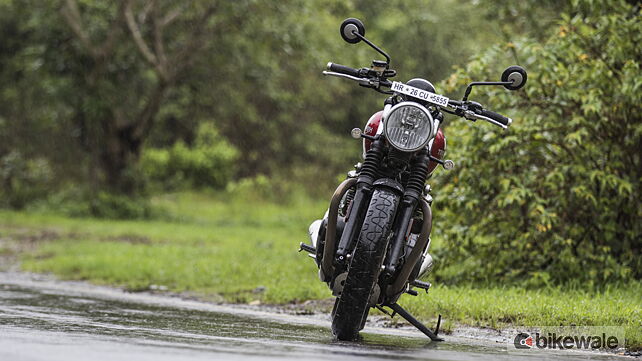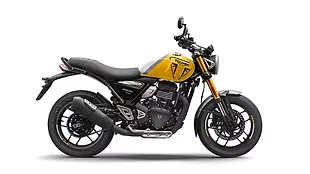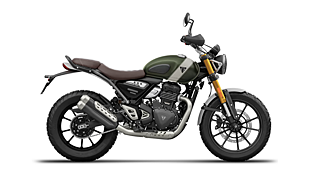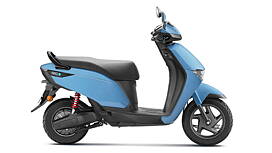What is it?

A modern classic. An entry-level Triumph. Ducati Scrambler competitor. Or simply a large capacity, torquey motorcycle, which, in a welcome change, isn’t intimidating at all. Say hello to the Triumph Street Twin, which might look retro, resemble the older Bonneville and seem simple, but is brand new and a whole lot more modern than before.
The Street Twin is a generation ahead of the old Bonnie in the truest sense. It has a new engine, new frame, new cycle parts, completely new styling, and some handy electronic aids. Plus, when you walk up close, get astride and spend sometime riding it, you learn, it’s all for the better. And not just for newbie riders, mind, but for a motorcyclist in general.
How does it ride?

Now, if I were to best sum up the riding experience of the new Triumph Street Twin in one word, it would be easy. It has a low seat height, easy to reach handlebar, upright seating, and the engine – no matter how daunting it might seem on paper being 900cc and all – on the road, its power delivery is approachable and exploitable even.

The engine is a liquid cooled parallel twin. It makes around 55bhp but it is the torque of 80Nm that really gives the Street Twin its identity. The engine is mated to a 5-speed gearbox, comes with a slip-assist clutch and there’s traction control too. On the road, the light clutch feel is a boon. And when you give the bike your all from a standstill, the Street Twin doesn’t take off with frightening ferocity; in fact, it is slower than a few lesser capacity modern bikes.
But it is still fast. Only thing is, it gathers momentum at a pace that allows you to keep the throttle pinned without having to tamper it. It’s more like a German Shepherd than a Rottweiler; sure it can tear you apart, but it’s more sociable. But, to truly enjoy the Street Twin, one must ride its meaty torque wave.
Short shift, open gas, and you can instantly feel the potency of those large thumping pistons between your legs. And while doing so, these produce large chunks of torque that take you to the ton and beyond in no time. It makes the Street Twin a quick bike to commute in the city with, and an equally relaxed highway cruiser. It is refined, vibe-free and quiet too; till the time you don’t rev it.

As far as ride and handling goes, the Street Twin has an acceptable slow speed ride. But, it only works over slightly broken tarmac or bumps. Give it something severe, and the front just crashes into it, including flyover joints. It’s not the best to tackle undulating roads with either, especially at speed. The front works fine here, but the rear on the Street Twin first begins to pogo over undulations. And soon enough, it runs out of travel and begins kicking the rider uncomfortably.
Handling, again, isn’t anything to write home about. The Street Twin’s straight-line stability and braking is acceptable, but the handling is still old-school. It is no doubt a big improvement over the older Bonneville, but it still can’t compete with modern machinery.

It doesn’t turn into corners willingly and one has to fight the bike to keep the intended line. It also gets into an uncomfortable weave every time it encounters a mid corner bump, ripple or pebble. It is slightly better around longer, faster corners that require less lean and steering input, but around tighter bends and quick direction changes, the Street Twin is work.
Anything else I should know?

Let us get the negatives out of the way first…
The Triumph Street Twin might have a light clutch and an easy to wring throttle which eases city riding, but one must struggle with the bike’s low-gear-high-rpm throttle snatchiness, nonetheless. The gearshifts are clunky too, and if you ride the bike hard, you’d also have to live with an engine which when revved gets loud and vibey. Then there’s the Street Twin’s slow and heavy steering. It affects its turn-in ability but it also makes the bike cumbersome at slow, city-speed manoeuvring . It’s a good workout for your arms, though.
…Then there was good news.

I love the styling – simple, soothing and attractive. The Street Twin is also high on quality and finish. And, the bike has all the necessary rider aids. There’s ABS and traction control, and we did end up calling on the former quite often, courtesy wet roads, average Pirelli rubber, and an overzealous rider, which would be me.

We love the switchgear, the easy to access rider information, and the Brat Tracker kit our press bike came with. The kit, one of three inspiration kits Triumph sells along with the Street Twin, does push the price up by around Rs 85,000.

But then, you do get nicer looking and sounding tail pipes, a smarter seat, nicer grips, new tail lamp, and LED turn indicators. The kit also includes an aluminium bash plate, which to us seems like a good add-on given the Street Twin did scrape its belly over a few speed breakers. One can also order Scrambler and Urban inspiration kits for similar money.

Now to goodies that come as standard. The Street Twin gets a locking fuel filler cap, USB charging, adjustable clutch and brake levers, and a simple looking instrumentation with readouts for two trips, average and instantaneous fuel efficiency, gear indication, fuel level, time and tank range.
Should I buy one?

Want a Triumph? But, don’t want to splurge? Well, then you can’t really have anything. But, the Street Twin is the most affordable Triumph in India currently. And it is easy to ride. One can commute on it, go intercity riding, and if not ridden hard, it’s difficult to fault the Street Twin. However, if you like to keep that throttle pinned, or round bends with kid like enthusiasm, or hate slowing down for poor roads, speed breakers or water streams, the Triumph Street Twin might not rock your boat.

Where does it fit in?

It might be Triumph’s entry-level motorcycle, but the Street Twin – minus the Brat Tracker kit – still retails for over Rs 8.0 lakh on the road. Which is expensive. For similar money you also get the more versatile and hardier Ducati Scrambler. It is lighter, more powerful, but lacks the refinement and calm nature of the Triumph. But, that’s not all; you can also get the Kawasaki parallel twins for the same money, the ER-6n, the Ninja 650 and even the very likable Versys 650.
Photography by Kapil Angane
Click here to read the Ducati Scrambler Icon First Ride Review
Click here to read the Kawasaki Versys 650 First Ride Review
Gallery
1/54
Double Tap to Zoom
























![Triumph Street Twin [2018] Image Triumph Street Twin [2018] Image](https://imgd.aeplcdn.com/272x153/bw/models/triumph-street-twin.jpg?20190103151915&q=80)

























